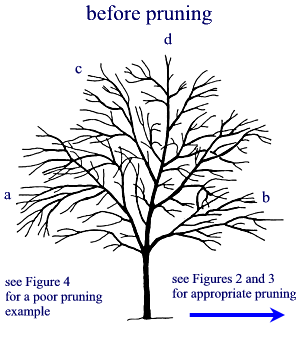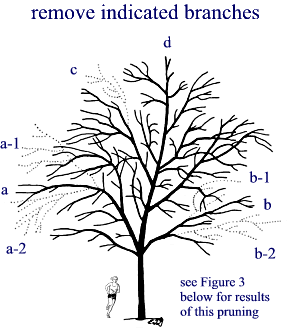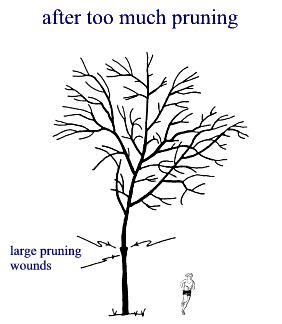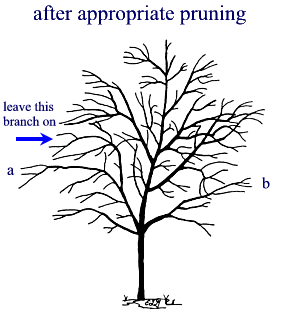Home > Pruning shade trees > Raising or lifting canopy
Raising or lifting the canopy
| Raising the crown: the standard way Raising the crown: a better way Raising impacts Management comparisons Raising examples Printer-friendly (2 page pdf) |
Don't do this |
Objectives
1) Keep low branches small with regular reduction cuts so that trunk wounds are small when branches are eventually removed. 2) Prevent low branches from growing up into the canopy by reducing or removing upright-growing stems and branches.
Figure 1: Problem - Branches are drooping low and will be in the way of pedestrians or vehicles. The low branches will eventually have to be removed so shorten them now to prepare for this. Allowing them to grow unchecked could result in them growing to a large diameter. Decay could result if the large diameter branch is removed later. |
Figure 2: Good solution - Subordinate lower vigorous branches 'a' and 'b' by removing upper and lower lateral branches a-1, a-2, b-1 and b-2. Removing a-1 and b-1 ensures that these branches will not grow up to become part of the permanent canopy. This is important because left unpruned, these branches are likely to remain vigorous, forming weak codominant stems. Removing a-2 and b-2 helps to lift the canopy to provide clearance. Subordinate branch 'c' because it will compete with the leader 'd'. |
Figure 4: Poor solution - Removing the three lower branches entirely leaves large pruning wounds that could initiate trunk decay. The tree also looks as though it was pruned, a situation often associated with poor tree care carried out by untrained workers. Raising the canopy all at once could also cause tree failure by leaving too much weight at the top of the tree. To avoid lack of balance after canopy raising the distance between the bottom and top of the canopy should be at least 2/3 the height of the tree. Removing three large branches all at once from the same position on the tree could also cause trunk defects such as decay and cracks. |
Figure 3: Good solution executed - Lower branches were subordinated (branches were removed from the ends with reduction and removal cuts) to slow their growth so they won't droop as quickly and get in the way. Subordinating instead of removing a large branch (removing is shown in Figure 4) is more attractive and is better for the tree. The slower growth on 'a' and 'b' means these branches will eventually be small in diameter compared to the trunk. This is desirable should these branches have to be removed later because there is less chance for trunk decay. Branches 'a' and 'b' might have to be subordinated at a later date to further slow their growth. The large, inner branch was left on branch 'a' because it was not growing upright and it originates from the inner portion of the canopy. The branch 'a' could also be cut back later to this more upright oriented branch to provide more clearance. |
Introduction
Large, low branches are fine for trees growing in parks and other open landscapes where passage under the canopy is not needed. However, in more urban settings low branches may be undesirable on established trees because they obstruct vision and may interfere with pedestrian and vehicular traffic. A large wound and possible trunk defects could result should they have to be removed. Low branches on young trees that are allowed to develop can become more problematic with time as they droop and get in the way.
Canopy
lifting or raising should be performed on young and medium-aged trees to prevent
low branches from growing to a large diameter. Crown lifting shortens low branches
regularly to suppress their growth. This forces more growth in the upper branches.
This form is most suitable for urban landscapes. The shortened branches are
later removed to raise the crown for under clearance. This sustainable technique
damages the tree less than allowing low branches to grow to a large size and
them deciding to remove them. Keeping low branches small will also increase
the value of the lower trunk should the tree be cut into lumber when it is removed.
Execution
Instead of removing large low branches all at once, slow their growth by reducing their length if they will need to be removed later. Compared to removing the entire branch back to the trunk now, reduction of their length 1) is more attractive, 2) minimizes the size of the trunk wound when the low branches are eventually removed, and 3) helps prevent decay and cracks from entering the trunk.







